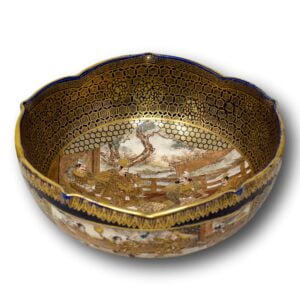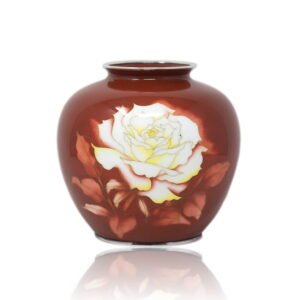Description
Japanese Satsuma Processional Vase
From our Japanese Satsuma collection, we are delighted to introduce this Japanese Satsuma Vase by Kinkozan.
The vase, with a compressed body on a circular foot and a flared neck, is decorated with a continuous processional scene. Figures in traditional attire fill the central band, including one on horseback and others carrying banners and poles. The procession unfolds across a gradient grey ground, enhanced with extensive gold spots that intensify towards the top rim.
A gilt geometric border completes the neck, while the base is decorated with scattered polychrome stars, adding a distinctive detail. The underside is signed Kinkozan 金光山. This Japanese Satsuma Vase dates to the Meiji period (1868–1912).
KINKOZAN 金光山
the Kinkozan family have been associated with pottery dating back to 1645. They went on to become the largest producer of Satsuma ware by one individual company, from the end of the 19th century until 1927 after which the factory closed. By the 1850s Kobayashi Sobei (1824-84), Kinkozan Sobei (artist name Kinkozan IV), started to export his products together with the Kyoto manufacturer Taizan VIII. The main target market was America with their main production period approximately between 1875-1927 under the leadership of Kinkozan V(1868-1927).
For further information please see our makers and retailers page on Kinkozan.
MEIJI PERIOD (1868-1912)
The Meiji era marked Japan’s transformation into a modern nation and a golden age of decorative arts. With the end of samurai rule and Japan’s opening to the West, artisans produced works of exceptional quality for both domestic and international audiences. Supported by the government through world fairs and Imperial commissions, Japanese lacquerware, cloisonné, satsuma ceramics, bronzes, and ivory carvings reached collectors worldwide. Many leading artists of the time, including Makuzu Kozan and Namikawa Yasuyuki, were honoured as Imperial Household Artists, ensuring the Meiji period remains one of the most celebrated eras of Japanese art.
For further information please see our article Japanese Meiji Period: Art, Collecting, and Cultural Transformation.
SATSUMA WARE
Satsuma ware originated in southern Kyūshū around 1600 and developed into one of Japan’s most recognisable ceramics. Early Ko-Satsuma pieces were rustic, dark-clay wares made for everyday use, while the later Kyō-Satsuma style became famous worldwide during the Meiji period.
Characterised by ivory crackled glaze, delicate overglaze enamels, and lavish gilding, export Satsuma appealed strongly to Western collectors. Designs often feature landscapes, flowers, figures, and scenes from Japanese life and mythology. Renowned artists such as Yabu Meizan, Ryozan, and the Kinkōzan workshop produced some of the finest examples, which remain highly sought after today. Genuine Satsuma can often be identified by the Shimazu crest, artist signatures, or the mark “Dai Nippon” used during the Meiji era.
For further information on the history of Satsuma Wear please see our article Japanese Satsuma Ware.
MEASUREMENTS
11cm High x 11cm Diameter (4.33 x 4.33 Inches)
CONDITION
Excellent
With every purchase from Jacksons Antique, you will receive our latest product guide, certificate of authenticity, full tracking information so you can monitor your shipment from start to finish and our personal no-hassle, money-back policy giving you that extra confidence when purchasing. Don’t forget to sign up to our free monthly newsletter for 10% off your first online purchase.































